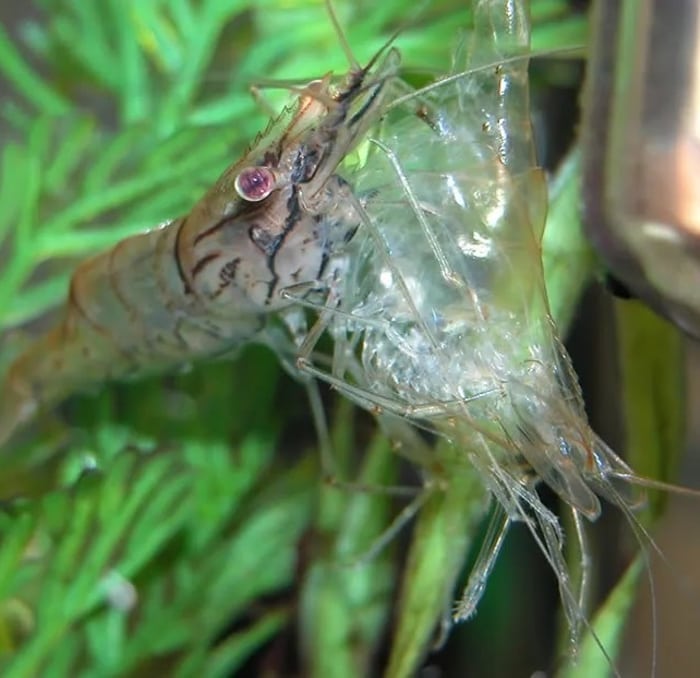Hey there, fellow shrimp enthusiasts! As someone who’s kept shrimp for years, I’ve seen my fair share of molting episodes. Today, I’m gonna break down everything you need to know about shrimp molting and whether it’s actually a good sign or not.
The Quick Answer
Generally speaking yes – regular molting is usually a positive sign that indicates your shrimp are growing and healthy. However there’s more to the story than just that!
What Exactly is Shrimp Molting?
Think of molting like your shrimp getting a whole new outfit because they’ve outgrown their old one. Here’s what happens:
- Shrimp shed their outer shell (exoskeleton)
- They absorb water to expand in size
- A new, bigger shell forms and hardens
- This process happens every 3-4 weeks in adult shrimp
- Young shrimp molt more frequently (every 1-2 weeks)
How to Tell When Your Shrimp is About to Molt
Before molting, your shrimp will show these telltale signs:
- They become super still and inactive (like, weirdly still!)
- May stop eating
- Might hide more than usual
- Look slightly milky or opaque
- Show white patches on their shell
Why Molting is Generally Good News
When your shrimp are molting regularly. it usually means
- They’re growing normally
- Water conditions are stable
- They’re getting proper nutrition
- Their environment is relatively stress-free
- The breeding cycle is active (especially important for females)
But Wait… Molting Isn’t Always Good News
Sometimes molting can happen because of stress. Here’s when you should worry:
- Multiple shrimp molting at once
- Molting too frequently
- White ring appearing around their body (yikes – the dreaded “White Ring of Death”)
- Shrimp getting stuck in their molt
Taking Care of Molting Shrimp
Here’s what we do in our tanks to support healthy molting:
Water Parameters
- Keep GH and KH stable
- Maintain consistent temperature
- Don’t make sudden water changes
- Test water regularly
Diet Tips
- Feed calcium-rich foods
- Include protein sources
- Offer varied diet (algae wafers, veggies, biofilm)
- Let them eat their molts (yeah, they actually do that!)
Common Molting Problems and Solutions
The White Ring of Death
- Looks like a clear/white line around the body
- Usually caused by poor water parameters
- Can be fatal if not addressed quickly
Stuck Molts
- Shrimp might lie on their side
- May twitch continuously
- Usually can’t be helped (but some brave souls try using tweezers – super risky though!)
Should You Remove Molt Shells?
Here’s the deal – in most cases, just leave ’em be! The shells are like a calcium buffet for your shrimp. Only remove them if:
- You’re dealing with parasites
- There’s a bacterial infection in the tank
- The tank looks messy and you can’t stand it (keeping it real here!)
Final Thoughts
Molting is totally natural and necessary for shrimp growth. While it’s usually a good sign, the key is monitoring HOW they molt. Regular, successful molts? Awesome! Weird molting patterns? Time to check your water parameters and feeding routine.
Remember, every shrimp keeper’s gonna deal with some failed molts – it’s just part of the game. The important thing is learning from each experience and keeping those water parameters stable!
Pro Tips From My Experience
- Don’t panic if you see empty shells – it’s normal!
- Keep those water changes consistent
- Feed a varied diet
- Give your shrimp plenty of hiding spots
- Monitor but don’t helicopter parent – they know what they’re doing!
Got more questions about shrimp molting? Drop ’em in the comments below! And don’t forget to share your own molting stories – we’re all in this shrimpy adventure together!

The Challenges of Shrimp Molting: Problems and Solutions
Can during molting shrimps encounter various issues that can affect their chances of survival and well-being. Boredom is his important part of life shrimps, when shrimps unsuccessfully being able to get through their molting cat this can unfortunately be fatal. Some problems during shedding can be:
- Incomplete molt: Sometimes a shrimp may have trouble fully emerging from its old exoskeleton, stalling the process. This can result in a shrimp with parts of its old armor attached to its body, making it vulnerable to predators and infection.
- Difficulty curing: The hardening of the new exoskeleton after molting is a critical phase. If the shrimp is not enough minerals can absorb to properly harden the new armor, the exoskeleton may remain weak and the shrimp may have difficulty with normal activities.
The Molting Process in Shrimp: Growth, Challenges and Support
Molting is not only intriguing, but also vital to the growth and development of these small aquatic animals. In this blog we dive deeper into the molting process, discover why it is so important for shrimps, we discuss potential challenges and share tips to help you shrimps support for successful molting.
Why shrimp are molting (shedding skin)? Should you remove shrimp molt?
FAQ
How do you know if shrimp are happy?
Happy shrimps are grazing most of the time. If your shrimps are standing still for a longer period of time, they might be unhappy. Sometimes shrimps just don’t like the food you give them and won’t come for it. What kind of pellets are those?
Should I leave shrimp molt in the tank?
Do shrimp molt when stressed?
Do shrimp breed after molting?
Breeding occurs right after a female molts. She will then hide and release pheromones and the male will find her and breed with her.
